March 2025
The global fertility market size accounted for USD 39.27 billion in 2025 and is forecasted to hit around USD 85.53 billion by 2034, representing a CAGR of 9.03% from 2025 to 2034. The Europe market size was estimated at USD 12.16 billion in 2024 and is expanding at a CAGR of 7.38% during the forecast period. The market sizing and forecasts are revenue-based (USD Million/Billion), with 2024 as the base year.
The global fertility market size was calculated at USD 36.53 billion in 2024 and is predicted to increase from USD 39.27 billion in 2025 to approximately USD 85.53 billion by 2034, expanding at a CAGR of 9.03% from 2025 to 2034.
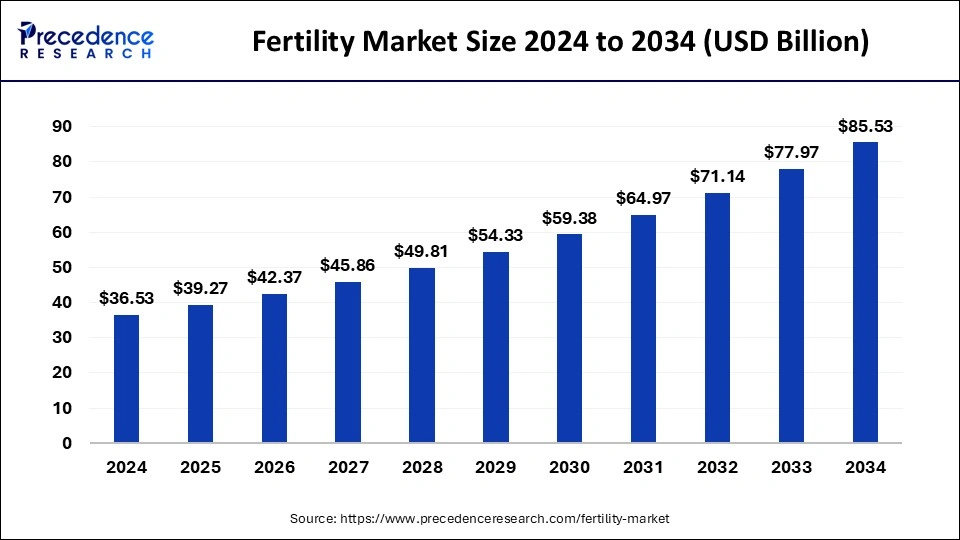
The Europe fertility market size was evaluated at USD 12.16 billion in 2024 and is projected to be worth around USD 24.46 billion by 2034, growing at a CAGR of 7.38%.
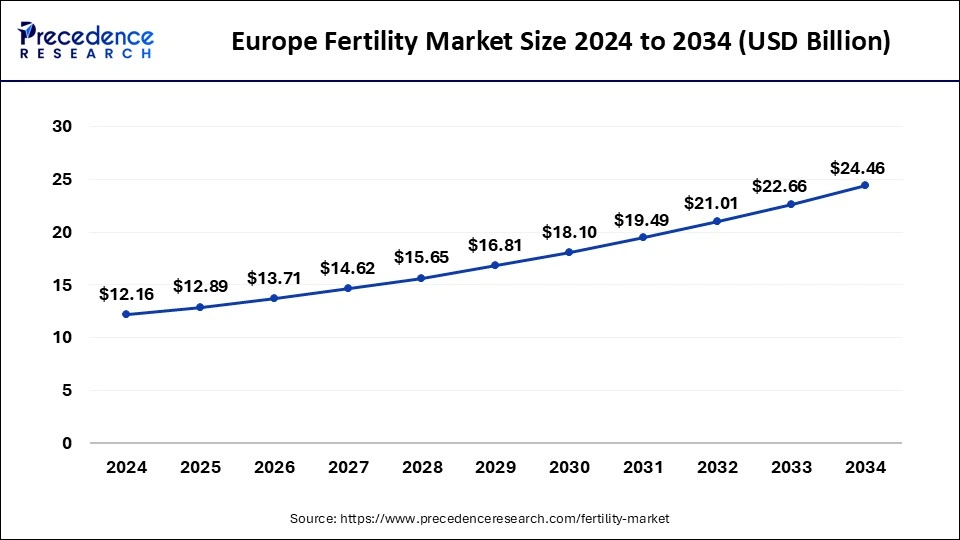
Europe held the largest share of 33.29% in the fertility market. In recent years, there has been an increase in demand for fertility treatments in Europe. This trend is influenced by elements like changing lifestyles, postponing childbearing, and an increase in infertility rates. Regulations pertaining to fertility treatments varies throughout European nations. While some nations have more lax laws that permit a variety of reproductive services, others have more stringent laws. Numerous fertility clinics providing a range of services, from sophisticated reproductive therapies to simple fertility assessments, can be found throughout Europe. These clinics frequently offer individuals and couples undergoing reproductive treatments individualized care and assistance. Certain individuals may choose to receive reproductive care beyond borders, which involves traveling to another country for fertility treatment, due to differences in rules and pricing among European nations.
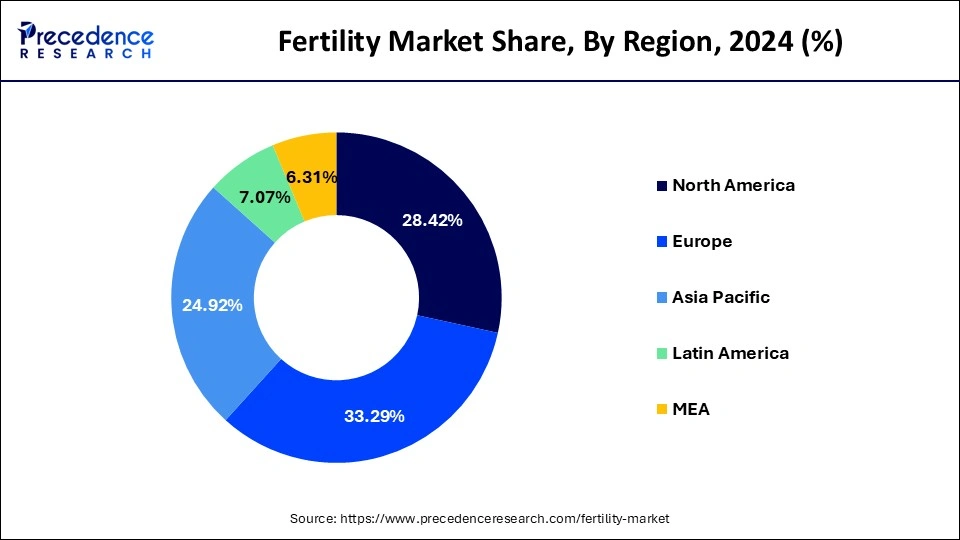
Asia Pacific also expected to grow at the fastest CAGR of 11.10% during the forecast period. Delays in childbirth, changes in lifestyle, and an increase in the prevalence of infertility problems have all contributed to an increase in the need for fertility treatments. The accessibility and efficacy of fertility treatments have increased due to advancements in assisted reproductive technologies (ART), such as intracytoplasmic sperm injection (ICSI), preimplantation genetic testing (PGT), and in vitro fertilization (IVF). Fertility treatments are becoming more affordable for couples thanks to financial assistance or subsidies from several governments in the Asia Pacific area. A greater number of couples are seeking assistance as a result of de-stigmatizing infertility and raising awareness of reproductive problems and accessible therapies. A number of nations are updating their ART laws to make them more accessible and inclusive to a larger range of people.
Research & developments are continually increasing in the healthcare industry for the infertility treatment which is expected to boost target industry growth in the near future. In the developed countries such as U.S and Canada the healthcare treatment, service costs are relatively high owing to availability of advanced healthcare infrastructure. Due to the ongoing healthcare technology advancements highly sophisticated tools and apps are used every day, around the globe. However, the emerging economies across the globe such as India, China are offering huge opportunities to the key operating players in the target market. Further, advancements in the healthcare infrastructure, coupled with growing medical tourism because of less costs of treatments are major factors boosting growth opportunities in the emerging economies, worldwide. Growth in the number of same-sex parents as well as solitary women selecting to have children has been exponential. All these factors are expected to boost growth and demand patterns for the global fertility industry in future.
| Report Highlights | Details |
| Growth Rate from 2025 to 2034 | CAGR of 9.03% |
| Market Size in 2025 | USD 39.27 Billion |
| Market Size by 2034 | USD 85.53 Billion |
| Base Year | 2024 |
| Forecast Period | 2025 to 2034 |
| Segments Covered | Offering, End-user, and Region |
| Regions Covered | North America, Europe, Asia Pacific, Latin America, Middle East & Africa (MEA) |
Future of the Global Fertility Market
Major companies of the global industry including Cooper Surgical and Cook Group are pointing towards commercial growth by adopting strategies like mergers and acquisitions, heavy investments in the manufacturing facilities that are predictable to flourish the global market growth in next few years. This trend is probable to continue and will augment growth of the target industry in the near future. For instance, in 2018, Cooper Surgical a leading player in the global industry acquired fertility business of Life Global Group. This has increased chances of a healthy pregnancies.
Delayed Childbearing Trends
The tendency of women opting to have children later in life, usually after the age of 35, is known as "advanced maternal age," or delayed childbearing. Over the past few decades, this practice has become more widespread in many industrialized countries for a variety of sociological, economic, and cultural reasons. There are effects of postponing childbearing on people and society at large. Individuals who become pregnant and give birth later in life run a greater risk of miscarriage, pregnancy problems, and genetic abnormalities in their progeny. The demand for fertility treatments and services, such as IVF, egg freezing, and other reproductive technologies, has surged due to the trend of postponing childbearing.
Limited Success Rates
Numerous reasons, including hormonal, physiological, and genetic problems, can lead to infertility. Determining the precise cause and implementing a successful solution might be challenging. Individual differences in success rates can be attributed to a variety of factors, including lifestyle choices, general health, and the underlying causes of infertility. The cost of fertility treatments can prevent many people from accessing them. Some patients might only be able to afford one or two treatment cycles, which would lower their likelihood of recovery. Stress itself has been shown to impact fertility, and infertility treatments can be emotionally exhausting. The success rates of treatments may be further impacted by his emotional load. Certain reproductive treatments are prohibited by law or ethical principles in some areas, which restricts the options available to people in need of help.
Regenerative Medicine and Stem Cell Therapy
Women who experience early ovarian failure or decreased ovarian reserve are being investigated for treatment with stem cell therapy. It is possible to inject stem cells into the ovaries to possibly promote the development of new follicles and enhance ovarian function. These stem cells can come from a variety of sources, including bone marrow or adipose tissue. The potential of stem cells to renew and repair the endometrium the uterine lining is being studied. Women who suffer from diseases like Asherman's syndrome, which can lead to infertility or repeated miscarriages, or thin endometrium may find this beneficial. Male infertility may also be treated with stem cell treatment. The progenitor cells, known as spermatogonia stem cells, are culturing and harvestable in vitro.
The assisted reproductive technology (ART) segment held the largest share of 70.97% in the fertility market. A wider spectrum of individuals now have greater access to fertility treatment thanks to ART treatments like intrauterine insemination (IUI), intracytoplasmic sperm injection (ICSI), and in vitro fertilization (IVF). The market for fertility clinics and related services is expanding as a result. The hazards connected with reproductive treatments have decreased and success rates have increased because to advancements in ART techniques. Better results for patients have been made possible by innovations like time-lapse embryo imaging, vitrification of eggs and embryos, and preimplantation genetic testing (PGT). The need for ART services has increased due to the rising occurrence of conditions such as same-sex parenthood, delayed childbearing, and medically-induced infertility.
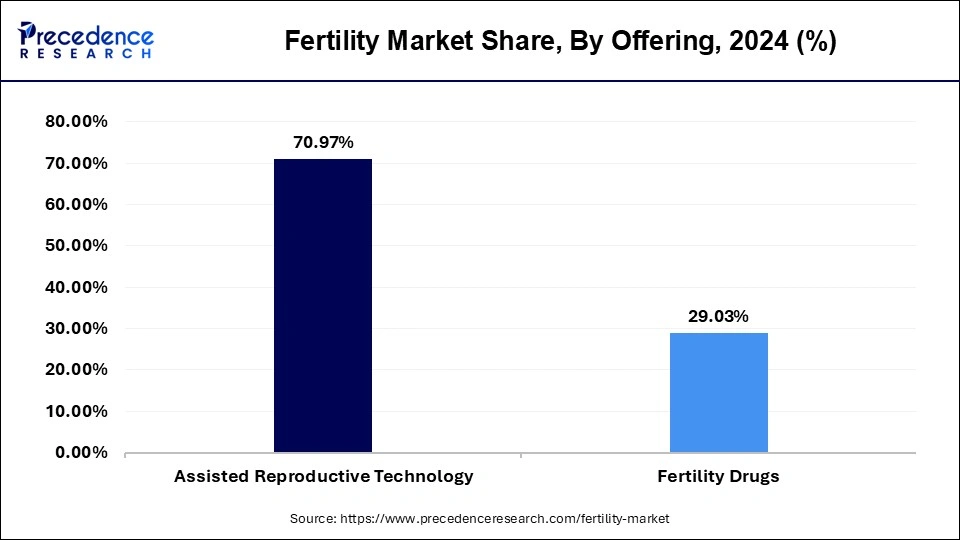
Global Fertility Market Revenue, By Offering, 2022-2024 (USD Billion)
| By Offering | 2022 | 2023 | 2024 |
| Assisted Reproductive Technology | 22.05 | 23.88 | 25.92 |
| Fertility Drugs | 9.78 | 10.18 | 10.60 |
Fertility tourism has increased as a result of differences in national laws and availability to fertility treatments. People might fly to nations with more affordable ART procedures or more benevolent policies, which would contribute to the globalization of the fertility market. For many singles and couples, the high expense of ART procedures can be a major barrier to access. Because of this, some fertility clinics provide financing choices or package discounts to lower the cost of treatment. The accessibility of ART services is further impacted by the large variations in insurance coverage for reproductive treatments. The increasing use of ART has brought up moral concerns about the discarding of embryos, genetic trait-based selection, and the commercialization of human reproduction.
In 2024, the fertility clinics segment held the largest share of 65.62% in the fertility market. Fertility clinics are essential to the reproductive industry because they provide a variety of services to people and couples who need help conceiving. These clinics offer a range of services to aid with infertility problems, such as sperm donation, egg freezing, fertility testing, intrauterine insemination (IUI), and in vitro fertilization (IVF). Due to reasons such postponing childbearing, raising awareness of fertility treatments, and improvements in reproductive technologies, the fertility market has experienced tremendous development in recent years. Due to this, fertility clinics have proliferated all over the world, varying in size from huge, specialized institutions to tiny, independent practitioners.
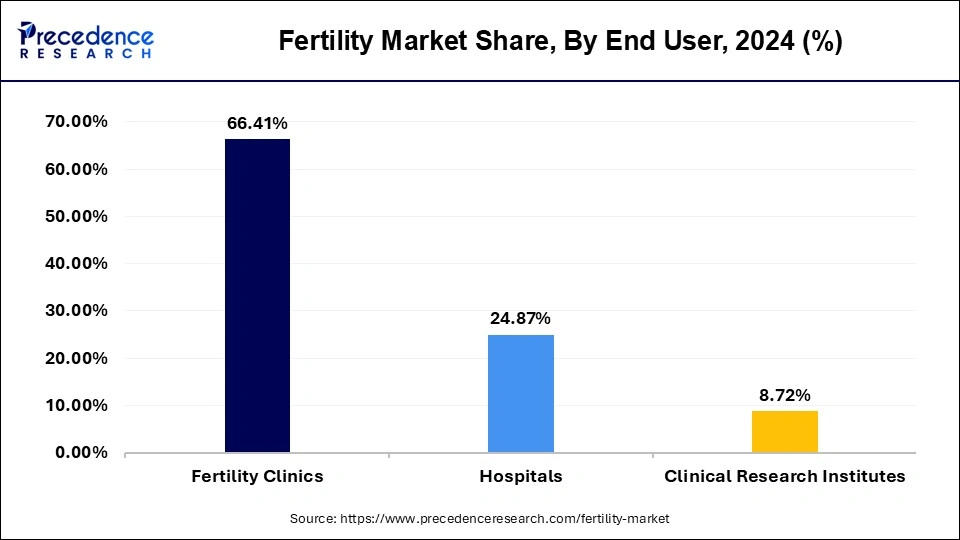
The hospitals segment is also expected to remain the second largest during forecast period. Specialized fertility clinics can be found on the grounds of many hospitals or as separate establishments. In vitro fertilization (IVF), intrauterine insemination (IUI), fertility testing, and other reproductive treatments are among the services provided by these clinics. For patients receiving medical treatments like chemotherapy or radiation therapy that may have an impact on their fertility, hospitals may offer fertility preservation services. This can involve freezing sperm or eggs for later use. To provide cutting-edge fertility treatments and procedures, hospitals usually work in conjunction with reproductive experts, such as reproductive endocrinologists, embryologists, and fertility doctors. For individuals and couples dealing with infertility concerns, hospitals frequently provide counseling, support groups, and instructional materials.
Global Fertility Market Revenue, By End User, 2022-2024 (USD Billion)
| By End User | 2022 | 2023 | 2024 |
| Fertility Clinics |
20.39 | 22.08 | 23.97 |
| Hospitals |
8.39 | 8.81 | 9.27 |
| Clinical Research Institutes | 3.05 | 3.17 | 3.29 |
By Offering
By End user
By Geography
For inquiries regarding discounts, bulk purchases, or customization requests, please contact us at sales@precedenceresearch.com
No cookie-cutter, only authentic analysis – take the 1st step to become a Precedence Research client
March 2025
May 2024